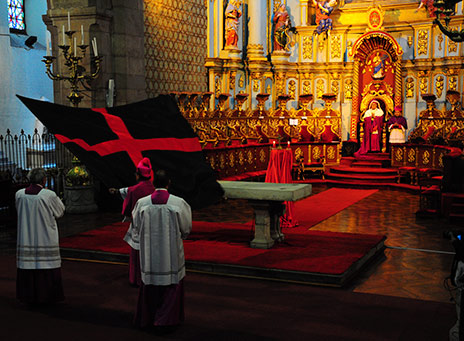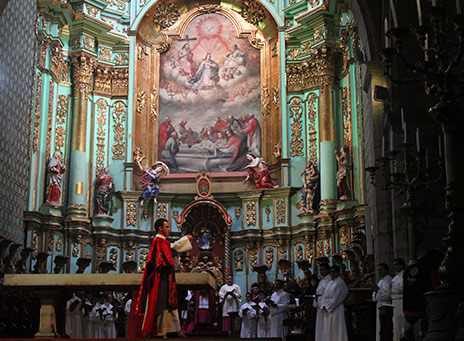
Semana Santa is an important celebration across Latin America, and Ecuador is no exception. It’s one of the most important times of the year in Catholic culture. Quito is home to some of the most unique Semana Santa traditions in the world. Holy Week starts with Palm Sunday (Domingo de Ramos). On this Sunday, Christians remember the day that Jesus entered into Jerusalem on a donkey. He was warmly received by his followers, who welcomed him to the city by laying down palm branches in front of him.
Another story recalled in Semana Santa is the Last Supper. On Maundy Thursday (Jueves Santo), Jesus and his twelve disciples gathered all together for one last time. It was here that Jesus began the practice of what is now known as Holy Communion, inviting the disciples to eat bread and drink wine, symbolic of the body and blood of Christ, before naming Judas as his betrayer and spending the rest of the night in the Garden of Gethsemane.
Arrastre de Caudas
On Holy Wednesday (Miércoles Santo) a unique ceremony takes place in Quito that is practiced almost nowhere else in the world. The Arraste de Caudas has its roots in an ancient Roman funerary rite. When a general died, a superior would a flag over the body, and then would wave the flag before the troops. They saw this as a way of passing on the strength and bravery of the general to the rest of the army. This tradition was later adapted to Christian practice. A ceremony for bishops in the archdiocese of Seville was based on this ritual, and from Seville the ceremony was brought to Quito, now the only city in South America where this ritual is practiced.
The ritual is carried out by eight canons dressed in black, wearing three items in particular: a cassock, a small cape and a detachable hood, and a train (cauda). The train is a long black cloth that the priests tie around their backs and drag along the floor. Some believe that if they touch this cloth, they will die within a year. The Archbishop wears purple, white, and golden robes that are embroidered with gold and silver threads. The black color symbolizes mourning for the death of Christ. White represents purity and purple is the color of penitence.
 The priests start from the main altar and process around the church accompanied by two acolytes, seminary students, who carry lit candles. The archbishop carries an item called the Santíssimo, a piece of jewelry that contains gold and precious stones. The Santíssimo is also said to contain fragments of the True Cross, actual bits of wood from Jesus’ cross. The relic was given to the National Cathedral by the Vatican itself, with an assurance of its authenticity.
The priests start from the main altar and process around the church accompanied by two acolytes, seminary students, who carry lit candles. The archbishop carries an item called the Santíssimo, a piece of jewelry that contains gold and precious stones. The Santíssimo is also said to contain fragments of the True Cross, actual bits of wood from Jesus’ cross. The relic was given to the National Cathedral by the Vatican itself, with an assurance of its authenticity.
The Arrastre de Caudas has been a tradition in Quito since the 16th century, and symbolizes the participants’ purification from sin. It takes place on noon on Holy Wednesday in the National Cathedral. Quito is one of the last places on Earth that still practices this unique and fascinating ritual.
